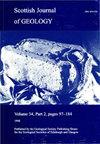Ranking the geothermal potential of radiothermal granites in Scotland: are any others as hot as the Cairngorms?
IF 0.5
4区 地球科学
Q4 GEOLOGY
引用次数: 14
Abstract
Prior investigations concur that the granite plutons in Scotland which are most likely to prove favourable for geothermal exploration are the Ballater, Bennachie, Cairngorm and Mount Battock plutons, all of which have heat production values greater than 5 μW m−3. This heat production arises from the significant concentrations of potassium, uranium and thorium in some granite plutons. A new field-based gamma-ray spectrometric survey targeted plutons that were poorly surveyed in the past or near areas of high heat demand. This survey identifies several other plutons (Ben Rhinnes, Cheviot, Hill of Fare, Lochnagar and Monadhliath) with heat production rates between 3 and 5 μW m−3 that could well have geothermal gradients sufficient for direct heat use rather than higher temperatures required for electricity generation. The Criffel and Cheviot plutons are examples of Scottish granites that have concentric compositional zonation and some zones have significantly higher (up to 20%) heat production rates than others in the same plutons. However, the relatively small surface areas of individual high heat-production zones mean that it is unlikely to be worthwhile specifically targeting them. Supplementary material: The full set of heat production data is available at https://doi.org/10.5525/gla.researchdata.302对苏格兰辐射热花岗岩的地热潜力进行排名:还有其他像凯恩戈姆一样热的吗?
先前的调查一致认为,苏格兰最有可能被证明有利于地热勘探的花岗岩深成岩体是Ballater、Bennachie、Cairngorm和Mount Battock深成岩体,所有这些岩体的产热值都大于5 μW m−3。这种热量的产生源于一些花岗岩深成岩体中钾、铀和钍的显著浓度。一项新的基于野外的伽马射线光谱测量针对的是过去或高热量需求地区附近调查不力的深成岩体。该调查确定了其他几个热生产率在3-5之间的深成岩体(Ben Rhines、Cheviot、Hill of Fare、Lochnagar和Monadhliath) μW m−3的地热梯度足以直接使用热量,而不是发电所需的更高温度。Criffel和Cheviot深成岩体是具有同心成分分带的苏格兰花岗岩的例子,其中一些区域的产热率明显高于同一深成岩体中的其他区域(高达20%)。然而,单个高温生产区的表面积相对较小,这意味着不太可能有价值专门针对它们。补充材料:完整的热量生产数据可在https://doi.org/10.5525/gla.researchdata.302
本文章由计算机程序翻译,如有差异,请以英文原文为准。
求助全文
约1分钟内获得全文
求助全文
来源期刊

Scottish Journal of Geology
地学-地质学
CiteScore
1.70
自引率
0.00%
发文量
10
审稿时长
>12 weeks
期刊介绍:
Although published only since 1965, the Scottish Journal of Geology has a long pedigree. It is the joint publication of the Geological Society of Glasgow and the Edinburgh Geological Society, which prior to 1965 published separate Transactions: from 1860 in the case of Glasgow and 1863 for Edinburgh.
Traditionally, the Journal has acted as the focus for papers on all aspects of Scottish geology and its contiguous areas, including the surrounding seas. The publication policy has always been outward looking, with the Editors encouraging review papers and papers on broader aspects of the Earth sciences that cannot be discussed solely in terms of Scottish geology.
The diverse geology of Scotland continues to provide an important natural laboratory for the study of earth sciences; many seminal studies in geology have been carried out on Scottish rocks, and over the years the results of much of this work had been published in the Journal and its predecessors.
The Journal fully deserves its high reputation worldwide and intends to maintain its status in the front rank of publications in the Earth sciences.
 求助内容:
求助内容: 应助结果提醒方式:
应助结果提醒方式:


